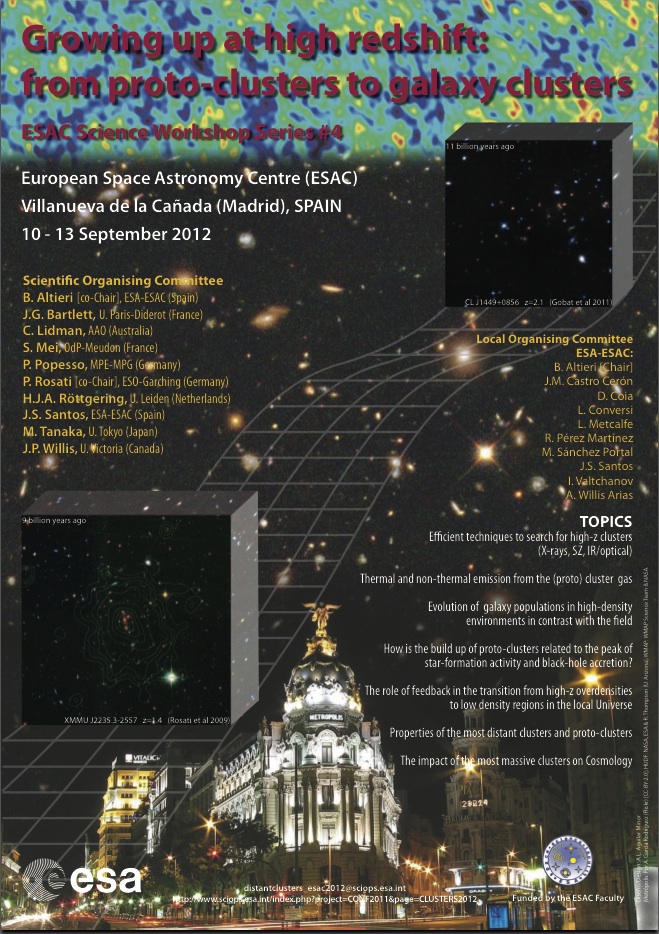Clusters2012 - Conferences Archive
|
Growing-up at high redshift: from proto-clusters to galaxy clusters 10-13 September 2012 European Space Astronomy Centre (ESAC) |
Purpose and Goals
Galaxy clusters represent the place where astrophysics and cosmology meet. Recently, the most distant (z>~1.5), massive clusters were discovered in IR and X-ray surveys, and the first high-z clusters discovered through the Sunyaev-Zeldovich (SZ) effect were found thanks to the new telescopes SPT, Planck, ACT. Massive (>~3.1014 Msun), high-redshift clusters are expected to be rare in the standard LCDM model. Therefore, robust mass measurements obtained from a combination of high-resolution X-ray and weak/strong lensing data are required to place stringent tests to the current cosmological paradigm. On the other hand, the underlying galaxy populations of these high-z clusters start to show signs of evolution relative to nearby systems, e.g. a reversal of star formation ("infrared Butchler-Oemler" effect). In this respect, the FIR Herschel data offers a new observational window, expected to provide valuable insights on their star-formation properties. Concurrently, significant progress had been done in the study of proto-clusters at z>1.6. A multi-wavelength approach is thus mandatory to gain a deeper understanding on the physical properties of these distant systems, obtain accurate mass measurements, and constrain the formation epoch of galaxy clusters. The aim of this conference is to discuss the latest results in this field obtained with data at previously unexplored wavelengths, and investigate future prospects with upcoming facilities such as ALMA, E-ELT, etc.
Main topics to be covered:
- efficient techniques to search for high-z clusters (X-rays, SZ, NIR/optical,...)
- evolution of galaxy populations in high-density environments in contrast with the field
- how is the build up of proto-clusters related to the peak of star-formation activity and black-hole accretion?
- what is the evolutionary sequence which led star formation to migrate from high-z overdensities to low density regions in the local Universe ? what was the role of feedback in this process ?
- properties of the most distant clusters and proto-clusters
- thermal and non-thermal emission from the (proto) cluster gas
- the impact of the most massive clusters on Cosmology
There will be no conference fee.
Invited Speakers :
Hans Boehringer (MPE, Garching, Germany)
Emanuele Daddi (CEA-Saclay, France)
Gabriella de Lucia (INAF-Trieste)
David Elbaz (CEA-Saclay, France)
August Evrard (University of Michigan, USA)
Marijn Franx (Leiden Observatory, The Netherlands)
Raphael Gobat (CEA-Saclay, France)
Henk Hoekstra (Leiden Observatory, The Netherlands)
Chris Lidman (Australian Astronomical Observatory)
Felipe Menanteau (Rutgers University, USA)
Florian Pacaud (Bonn University, Germany)
Adam Stanford (UC Davies, USA)
Bram Venemans (MPIA, Heidelberg, Germany)
Scientific Organizing Committee :
Piero Rosati (ESO, Garching, Germany) [co-chair] , Bruno Altieri (ESA, Spain) [co-chair], James Bartlett (JPL - Caltech, APC - Université Paris Diderot), Chris Lidman (AAO, Australia), Simona Mei (Observatoire Paris-Meudon, France), Paola Popesso (MPE Garching, Germany), Huub Rottgering (U. of Leiden, The Netherlands), Joana Santos (ESA, Spain), Masayuki Tanaka (IPMU, Japan), Jon Willis (U. Victoria, Canada)
Local Organizing Committe :
B. Altieri [chair], J.M. Castro Céron, D. Coia, L. Conversi, L. Metcalfe, R. Perez-Martinez, M. Sanchez-Portal, J.Santos, I. Valtchanov, A. Willis (ESAC).
Conference Poster
Important Dates
- 1 July 2011: First Announcement
- 1 February 2012: Second Announcement - Opening of Registration and Abstract Submission
- 15 May 2012: Abstract Submission Deadline
- 20 July 2012: Registration and Hotel Booking Deadline.
- End of July: Program online.
- 10 September 2012: Start of Conference
- 13 September 2012: End of Conference
CLUSTERS 2012 Organising Committee

- Removed a total of (7) style text-align:left;
- Removed a total of (7) align=center.
- Removed a total of (1) border attribute.








































 Sign in
Sign in
 Science & Technology
Science & Technology